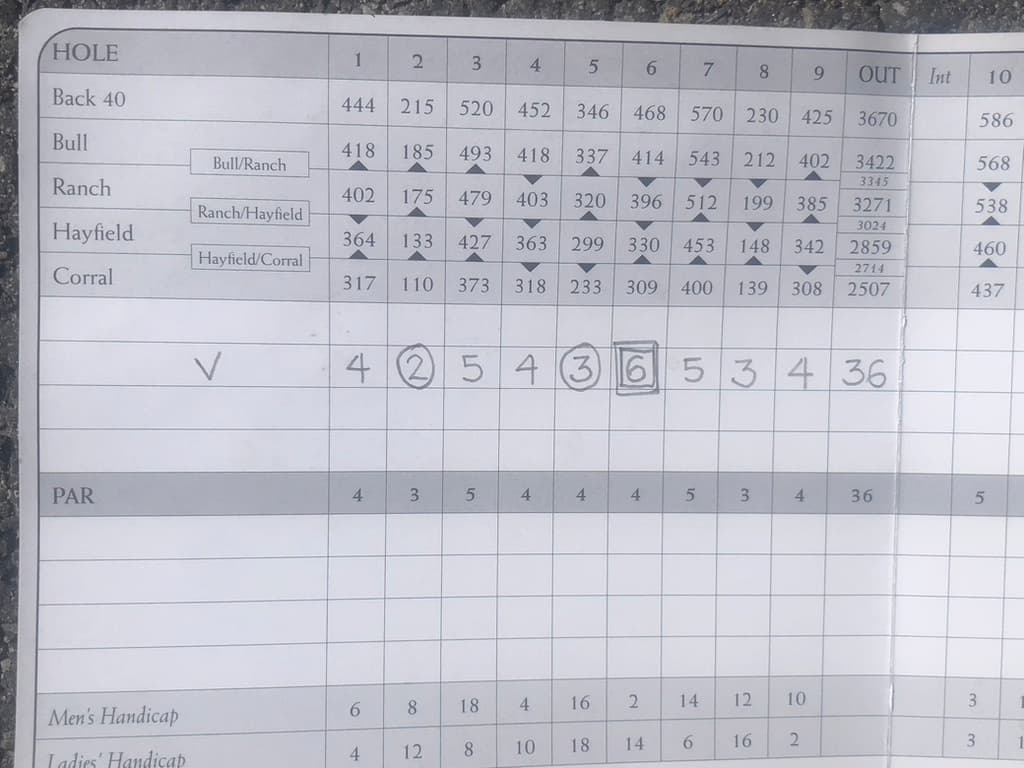To first understand what a Double Bogey in golf is, you first need to understand what Par is.
Each hole is allocated a certain # of strokes. This is the Par for the hole. This is the number of strokes the golf course expects you need to complete the hole. Pars can either be 3 (short golf hole), 4, or 5 (a long hole).
A double bogey occurs when a golfer takes two more strokes than par for a given hole.
A ‘buzzard’ is also sometimes referred to as a double bogey but it’s not commonly used.
Examples of the Scores That Result in a Double Bogey
Here are some examples of double bogeys:
- Use 5 strokes on a Par 3 hole
- Use 6 strokes on a Par 4 hole
- Use 7 strokes on a Par 5 hole
So a double bogey is always worse than a bogey. The scoring goal in golf is to use as few swings as possible.
Is a Double Bogey Good?
No, a double bogey is not good. But it is a common score among many amateur golfers. Double bogeys can be a result of many poorly executed things such as hitting your ball into the water hazard, taking multiple strokes to get out of a bunker or 3-putting.
While a double bogey is not a good score, you can certainly do worse.
What’s the Difference Between a Double Bogey, Triple Bogey and Quadruple Bogey?
The main difference between a double bogey and other scores is simply the number of strokes the golfer took more than par.
- A double bogey is when a golfer takes two more strokes than par for a given hole.
- A triple bogey is when a golfer takes three more strokes than par for a given hole.
- A quadruple bogey is when a golfer takes four more strokes than par for a given hole.
As you can see, the difference between these scores is simply the number of strokes that the golfer took more than par.
A double bogey is typically seen as a bad score to the average golfer, but it’s important to remember that even the best golfers in the world will sometimes make a double bogey.
What is a Net Double Bogey?
A net double bogey is a +2 on your scorecard after your strokes over par adjusted for any handicap stroke applied on that hole.
A Couple Examples of a Net Double Bogey
- 3 strokes over par (triple bogey, or a double par if you’re on a Par 3) minus 1 stroke handicap = final net score of 2
- 2 strokes over par (double bogey) minus 0 stroke handicap = final net score of 2
How Do I Avoid A Double Bogey?
You should never be happy with a double bogey. But there are times when it’s worse than others. Say if you’re competing against someone else who’s having a bad hole, you don’t want to lose the hole with a bad hole yourself. Or if you’re on the 18th hole and you’re 2 under your best score ever.
There is no surefire way to avoid making a double bogey, but there are a few things you can do to minimize your chances of doing so.
You can always play it safe with your strategy on each hole. For example, if you are standing on the tee of a long dogleg left and you’re not confident in your driver, you may want to lay up short with a 3-wood off the tee to ensure a more accurate tee shot. This is what’s called golf course management.
Another way to avoid double bogey is by practicing your problem areas on the course. If the course has thick rough that you often end up in, practice those shots when no one is around (hit an extra ball or two if no one is pushing you from behind) or if you can find a driving range with similar terrain.
Finally, always be aware of your score and know where you stand in relation to par. You can adjust your aggressiveness based on where you score stands in relation to par or against a competitor.
Some common bad habits that you can correct on the fly include not keeping your head down, having difficulty getting out of the sand trap and ensuring you have a proper backswing to start off on the right foot.
FAQ
Do professional golfers shoot double bogeys?
Yes, even the best golfers in the world will shoot double bogeys from time to time. It’s all part of the game, for every level of golfer. According to PGA golf statistics, a PGA Tour Pro will hit anywhere from 2 – 3 bogeys per round. Obviously double bogeys are even less than that, but it’s not unheard of.
Does Everyone Make Double Bogeys?
For the amateur golfer, the most common score is a Bogey with Double Bogeys also very common. So don’t get too down on yourself if you shoot a double bogey. Keep a short memory and move onto the next hole with a positive attitude.
How Do You Mark a Double Bogey on a Scorecard?
On your golf scorecard, a double bogey is indicated by adding 2 squares around the score. For a bogey, you simply add a single Square around the score.
In the featured image, you can see I scored a double bogey on a Par 4. So my score was a 6 and the 2 squares around it identify it as a double bogey. I also scored 2 birdies (identified with a circle), so my net score on this front 9 is even par.
Final Thoughts on Double Bogeys
Double Bogeys suck, let’s be honest. But they are going to happen to every golfer, even the Tour Pros.
The key is to learn from your mistakes and try not to repeat them. Practice common shots for a particular golf course on the driving range. Try to remember the basics of a good golf swing. And most importantly, stay positive and move on to the next hole with a fresh start.
If you’re reading this post, you’re most likely a recreational golfer. So remember why you started playing the game of golf and go out there and enjoy yourself.


